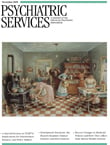Screening
Over two-and-a-half years, 5,169 mothers aged 14 to 49 were screened by telephone or mail. Of this group, 674 (13%) mothers scored ≥10 on the EPDS. The prevalence rate for the mothers who self-administered and mailed in the EPDS (N=260, 19%) was higher than for those who were screened with the EPDS by a nurse on the phone (N=425, 11%).
Most mothers screened were Caucasian (N=3,382, 66%), followed by Hispanic (N=620, 12%), black (N=449, 9%), Asian or Pacific Islander (N=401, 8%), and "other" (N=286, 5%). Thirty-one mothers did not indicate their race-ethnicity. The mean±SD age was 32.2±5.4, and the mean years of education were 16.3±2.9. A total of 2,478 (48%) were primiparas. A smaller proportion of white mothers (N=381, 11%) screened positive on the EPDS compared with Hispanic mothers (N=113, 18%), Asian-American mothers (N=69, 17%), mothers in the "other" racial-ethnic group (N=46, 16%), and black mothers (N=65, 15%) (p<.001). Compared with mothers who had at least a high school education, a greater proportion of those who were not high school graduates screened positive (p<.001).
Responses to open-ended questions
The first of the four open-ended questions asked mothers whether clinicians had asked about their emotional state. Of the 4,419 mothers screened who had seen a clinician by four- to six-weeks postpartum, 2,806 (63%) reported that they had been asked by the clinician about how they were feeling emotionally. In contrast, 1,613 (37%) reported that they were not asked about their emotional state by a clinician. No significant differences in age, education, or depression status (yes or no) were found between those who were and were not asked. Multiparous mothers were asked less often than primiparous mothers (p<.001). Asian, Caucasian, and Hispanic mothers were asked less often than black mothers and mothers in the "other" racial-ethnic category (p=.012). A total of 178 mothers with an EPDS score of ≥10 were not asked by a clinician about their emotional health.
Clinicians who were most often identified were pediatricians, obstetricians, nurse midwives, and nurse practitioners. When mothers were asked to elaborate, most reported that the clinician provided a specific checklist or asked specific questions about how they were feeling. Others reported being asked only general or informal questions about their emotional health.
The third question asked how the mother responded to the clinician's question about her emotional state. Most reported that their response was "fine," "good," "ok," "stable," or "had no problem." Other responses were categorized as "has social or health care support," feels sad or overwhelmed," "feels stress from other sources," "is seeking treatment for postpartum depression," or "feels stress related to breastfeeding or parenting." Seventy-three mothers with an EPDS score of ≥10 denied feeling sad when asked about their emotional state by the clinician.
The fourth question asked how the clinician followed up. Most mothers reported that the clinician offered some type of unspecified intervention, a psychiatric consultation or referral, advice, or emotional support. A handful stated that they were offered support but did not act on it. However, 91 mothers with elevated EPDS scores or who told the clinician that they felt "sad" were not offered any intervention.

